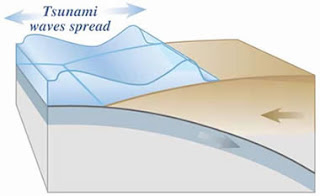A tsunami is a large ocean wave that is caused by sudden motion on the ocean floor. This sudden motion could be an earthquake, a powerful volcanic eruption, or an underwater landslide. The impact of a large meteorite could also cause a tsunami. Tsunami travel across the open ocean at great speeds and build into large deadly waves in the shallow water of shoreline.
Subduction zones are potential tsunami locations
 Most tsunamis are caused by earthquakes generated in a subduction zone, an area where an oceanic plate is being forced down into the mantle by plate tectonic forces. The friction between the subducting plate and the overriding plate is enormous. This friction prevents a slow and steady rate of subduction and instead the two plates become "stuck".
Most tsunamis are caused by earthquakes generated in a subduction zone, an area where an oceanic plate is being forced down into the mantle by plate tectonic forces. The friction between the subducting plate and the overriding plate is enormous. This friction prevents a slow and steady rate of subduction and instead the two plates become "stuck". Accumulated seismic energy
 As the stuck plate continues to descend into the mantle the motion causes a slow distortion of the overriding plage. The result is an accumulation of energy very similar to the energy stored in a compressed spring. Energy can accumulate in the overriding plate over a long period of time - decades or even centuries.
As the stuck plate continues to descend into the mantle the motion causes a slow distortion of the overriding plage. The result is an accumulation of energy very similar to the energy stored in a compressed spring. Energy can accumulate in the overriding plate over a long period of time - decades or even centuries. Earthquake Causes Tsunami
 Energy accumulates in the overriding plate until it exceeds the frictional forces between the two stuck plates. When this happens, the overriding plate snaps back into an unrestrained position. This sudden motion is the cause of the tsunami - because it gives an enormous shove to the overlying water. At the same time, inland areas of the overriding plate are suddenly lowered.
Energy accumulates in the overriding plate until it exceeds the frictional forces between the two stuck plates. When this happens, the overriding plate snaps back into an unrestrained position. This sudden motion is the cause of the tsunami - because it gives an enormous shove to the overlying water. At the same time, inland areas of the overriding plate are suddenly lowered. The moving wave begins travelling out from where the earthquake has occurred. Some of the water travels out and across the ocean basin, and, at the same time, water rushes landward to flood the recently lowered shoreline.
Deadliest Tsunamis in History
- Indian Ocean tsunami, 2004: 150,00 killed or missing in 11 countries. This tsunami unleashed the energy equivalent of 23,000 atomic bombs, according to the USGS.
- Java, 1883: Krakatou volcano erupted, triggering tsunamis that killed 36,000 people.
- Honshu, Japan, 1896: 27,000 killed.
- Chile, 1868: 25,000 killed.
- Mindanao, Philippines, 1976: Between 5,000 and 8,000 killed.
- Chile, 1960: 2,300 killed.
- In the U.S., the deadliest tsunami occurred in Hawaii in 1946. 165 people, including school children, were killed when a tsunami wiped out Hilo's waterfront. The government established a Pacific Tsunami Warning Center in Hawaii in the aftermath of that tsunami.


No comments:
Post a Comment